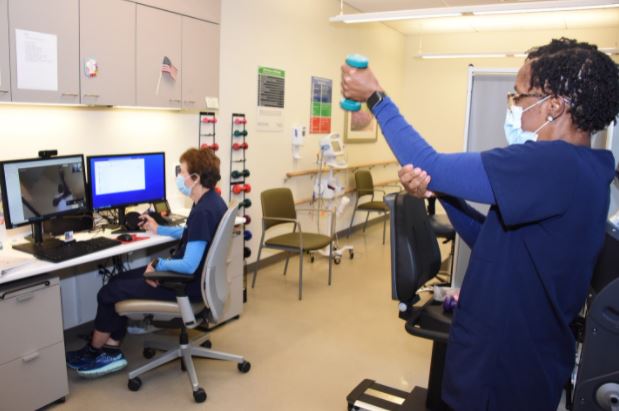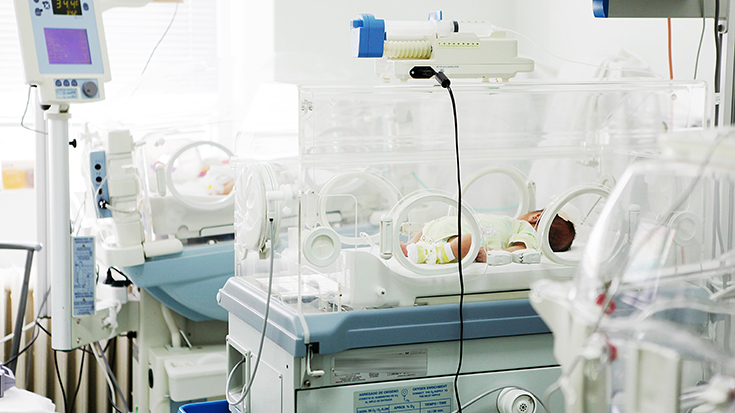
Lights, camera, action!
The COVID-19 pandemic required health care providers to find new ways to care for their patients. As a result, providers continue to consider patients’ ongoing needs along with the responsibility to keep them safe from COVID—especially those with pre-existing respiratory conditions. For example, the Pulmonary Rehabilitation (PR) Program at the Southeast Louisiana Veterans Health Care System worked with the Office of Connected Care to help patients continue their rehabilitation from home and even track their progress remotely.
On March 9, 2020, the first case of COVID-19 in Louisiana was diagnosed here at the Veterans Medical Center in New Orleans. Soon after, the Pulmonary Rehabilitation Clinic was closed to in-person visits. We had to find an innovative way to meet Veterans’ needs that didn’t involve face-to-face care. Our staff got to work designing a program that Veterans could participate in from home and without using the exercise equipment available at the medical center.
Challenge: Provide in-home care remotely
The first challenge in providing in-home care remotely was finding a way to connect with Veterans. The Office of Connected Care at VA helps practitioners and patients use telehealth applications to increase access to care. They assisted with the setup and use of connected devices to connect Veterans with their care providers. In addition, the Office of Connected Care developed four Centers of Excellence Teams in the VA system. One of these centers was located at Southeast Louisiana Veterans Health Care System in New Orleans participated. The Team helps clinicians foster adoption and use of combinations of mobile apps, the patient portal, wearable devices, and telehealth modalities.
 Mary LaBiche and Zina White.
Mary LaBiche and Zina White.With the help of our Center of Excellence Team, Adama Johnson, RN MSN NP-BC, and Mathew Lothian, LPN, we found that the VA’s Video Connect (VVC) app would work well for the program as we envisioned it. Veterans received iPads to connect with us using VA Video Connect, along with oximeters to measure their vital signs. The Bluetooth oximeters allow us to see vital signs in real time. Adama Johnson and Matthew Lothian also issued Fits Bits to qualified patients and provided any needed training.
After the patients received their devices, the Connected Care team helped familiarize them with the devices and how to connect to appointments. Initially, this process was challenging due to the lack of computer experience of some Veterans. However, with training and encouragement, all our patients learned to use the VVC app and iPad, and we were ready to begin our sessions.
The technology helped us create an online environment of care. Still, our in-person sessions typically include exercise equipment that we could not easily provide for home use. So, we turned to our exercise physiologist to help develop a routine that would provide an appropriate level of exercise to promote rehabilitation. We settled on Thera-Bands, small weights, and a pedal exerciser for home equipment for our virtual classes.
Our exercise program was developed for our Veteran population, consisting primarily of patients with COPD and restrictive lung disease. The program features an exercise routine that includes a warmup, a weight routine, walking in place or using a pedal exerciser, Thera-bands, and a cool down. We hold 60-minute sessions two days a week.
Finding success and connection with new technology
As with introducing any new health care service, we were a little unsure whether the program would be successful. However, the classes started and, to our surprise, were a great success! The Veterans quickly created a bond with each other in the group video sessions. The opportunity for togetherness gave them another incentive to attend class, likely due to many of them experiencing isolation associated with COVID-19 safety measures.
The social benefits were an unexpected bonus that accompanied positive clinical outcomes for patients who participated in the program. Before entering the program, some of our patients could barely walk in place for two minutes but gradually increased to 10 minutes. We have also documented increases in activities of daily living with less shortness of breath. Outcome measurements, such as St. George’s Respiratory Questionnaire used to assess the quality of life, and the Two-Minute Step in Place Test, which evaluates endurance, validates overall improvement. Patient satisfaction has been positive, making the program a great success overall.
Expanding the connection
To keep our patients motivated and engaged with their care, we used another VA Connected Care app called Annie. Annie is a text-messaging service that promotes self-care for Veterans enrolled in VA health care. Patients using Annie receive automated text messages to help them take charge of their health. The application can also send motivational and educational messages. In addition, there are pre-designed templates or protocols which clinicians can assign to their patients. Some of the topics include blood pressure, diabetic care, and weight loss. Seeing the potential that Annie held for pulmonary rehabilitation patients, we worked with the Connected Care team to develop prompts to help our patients manage their rehabilitation.
The pulmonary rehab protocol in Annie encourages patients to exercise, perform pursed-lip breathing, and safely carry out activities of daily living. Some messages prompt patients to submit data such as how many minutes they exercise. The data is stored in the Annie app which is held in the VA database. Clinicians can also graph and analyze data from the Annie app. The Pulmonary Rehab Specialist can give feedback or encouragement to patients. Other messages are purely motivational or educational.
The number of messages and the times delivered can be adjusted as patients become more adherent New graduates from our VVC program get more frequent messages. Later, depending on the patient’s response, the number usually decreases. At any time, a patient can enter STOP, and the messages are discontinued. Most of our patients have found the reminders and messages helpful. This messaging system has been another way to connect with our patients over this last year.
By bringing in colleagues in other disciplines, the Pulmonary Rehab Program has developed several innovative ways to connect with patients. In doing so, we found that many Veterans we serve prefer the convenience of telehealth rather than face-to-face appointments. We plan to continue using virtual pulmonary rehab classes, the Annie app, and connected devices even after the pandemic ends. The lessons learned will help us improve access to care and increase patient adherence by reducing barriers. Ultimately, the more options available will lead to better outcomes and a healthier, more satisfied patient population.
Start slow, and grow from there
Our Pulmonary Rehab VVC classes started slowly with only two patients in August 2020. The program has grown to two classes with four patients in each class with plans to expand. Due to the nature of the acuity of our patients, we must be able to see and monitor them throughout the class. The computer monitor size needs to be large enough to see the patients clearly when you have several patients. The Bluetooth oximeters have also helped with monitoring patients. As previously stated, the biggest challenge has been getting the patients oriented to the technology and virtual medium. Our Connective Care Team has been instrumental in this endeavor.
After the patient is oriented to the VVC app and iPad, which can be done in person or by phone, the pulmonary rehab team schedules a PR orientation session. This practice has helped make the initial session operate more smoothly. During the orientation session, the patient practices connecting to an appointment, and the RT-PR Specialists conduct a mini-class session. The patient is helped with setting up the IPAD in a strategic location that affords the best visual to the RT and a clear visual to the patient during the guided exercise therapy. We also get them to set up a place so that their exercise equipment will be at easy reach. For patient safety, it is important to establish emergency contact information for the veteran in the event of an adverse event. The emergency contact will be alerted, and e-911 will dispatch an Emergency Response Team to the patient’s location.
Tips for implementing your own program
Below are a few important strategies to help others who would like to employ connective devices in their PR program:
- Develop an exercise program that patients can do at home with minimal equipment.
- Have a Help Desk or Connective Team that can assist patients in learning their device, downloading applications, and connecting to appointments.
- Have a practice or orientation session before their first video class with other patients
- Collaborate with teams in your facility to use the available resources.
With the advent of the Delta variant many of the clinics are again closing. This can have devastating effects on our patient population. We have been able to expand our VVC classes without closing our clinic. The collaborative effort of team members and embracing new technology has allowed us to provide continuity of patient care during a pandemic.
Email newsroom@aarc.org with questions or comments, we’d love to hear from you.













